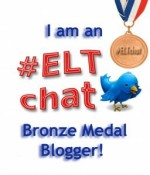Dictionary definitions of monitoring include:
To check the quality or content of something.
To keep track of systematically with a view to collecting information.
To keep close watch over; supervise.
Classroom monitoring can, I think, involve all of these aspects, and doing it well is a key teaching skill. We’ve all seen (or probably been) teachers who either breathe down students’ necks, making them desperately uncomfortable, or who wander off and start doing admin tasks at the back of the room (though the latter might just be monitoring very subtly!)
Monitoring to check the activity
As students start a task, it’s very important to check they know what they’re doing and that they are able to do it. So, although you might want to back off in order to make them feel less self-conscious, you probably need to at least subtly look around and see if people are on-task. Listen in unobtrusively, perhaps while doing those admin tasks, and make sure they’re ok. If one pair or group is uncertain about what to do, go and help them. If more than one pair or group is uncertain, I’d advise against going round and helping them all. It’ll take too long, and waste precious time for those waiting to see you. This is how I failed my O level maths (that, and too much gossiping). Just stop the activity and set it up again. And this time, check your instructions.
This kind of monitoring is simply pragmatic, and about helping things to run smoothly. It’s most important at the beginning of a task, but you can also do this kind of monitoring while a task is in progress to see if a group have finished early, if they need more support or more challenge and so on. Especially if you’re teaching young learners, you can also assess if they are starting to tire of the activity, and if you need to swiftly bring it to a close before all hell breaks loose.
Monitoring to assess language and/or skills
The other main reason for monitoring is to assess the language the students are producing (or their skills). This is vital if you want to be able to use your skills to actually help students develop. If you aren’t listening or paying attention, how can you possibly have any idea what they can do, or what they still need help with? “If a tree falls in a forest and no one is around to hear it, does it make a sound?” Well, of course, students are still able to listen to each other, and to themselves, but I hope you get my point.
How?
Perhaps you’ve heard about the secret handshakes that Masons are supposed to use to recognise each other? There’s a secret way that trainers who were trained up at International House (IH) can do this too….they crouch. Well, maybe not all of us, but I’ve recognised a few fellow ex-IHers this way. The idea is that by getting down on the students’ level, you’re less obtrusive and threatening. I think there’s something in this, but if students aren’t used to it, it can be a bit discombobulating for them (I knew I’d get to use that word in a blog post one day!)
It also isn’t great if you’re wearing a shortish skirt.
Being unobtrusive is important, however. You could try sitting at a short distance and looking elsewhere while your ears work overtime. If you really want to freak them out, look at one pair while listening to another, and then comment on what the second pair said. In a smallish class, it can also work quite well to sit on a chair in the middle of the room and lean forward. It signals that you’re listening, but isn’t too (literally) in your face. If students are writing, you’ll need to get closer. Try walking behind as these means they don’t have to stop what they’re doing and turn their book round to show you. It also helps to learn to read at strange angles.
Try not to get too involved with a group as this means you can’t tell what’s going on elsewhere. This can easily turn into small group teaching, while the rest of the class feel ignored, get bored, start throwing paper aeroplanes…. This (small group teaching, not throwing paper aeroplanes) might be OK in some circumstances, though. For example, with a longer project-like activity, once you are SURE everyone knows what they’re doing and can work independently.
What should you be listening for?
Obviously this depends on what the students are doing. Here are some suggestions.
Speaking tasks
Are they using the language you’ve been working on in class? Bear in mind that if they aren’t, it might be because you (or the coursebook writer) hasn’t designed the task very well.
Is the language you plan to focus on already being used naturally? If not, that will provide a ‘gap’ for you to feed language into later- as in task-based learning.
Can you identify a gap, or language they need to do the task more effectively? If so, make a note, teach it at the feedback stage, and then let them do the task again.
Grammar or vocab exercises
Monitoring should tell you which students are finding it easiest, and which are struggling. How many are struggling? (Do you need to deal with this whole class or on an individual basis?)
It’s also a great opportunity to think about who you are going to nominate at the feedback stage. You don’t want to put people on the spot [unless they really deserve it ;)] by asking for answers they don’t know. It can also be a good idea to give a weaker student a boost by nominating them when you know, from monitoring, that they’ve got the answer right.
After monitoring
As well as carrying out feedback on a task, or conducting an ‘error correction slot’ (where you write mistakes you heard on the board, anonymised and ask students to try and correct them), you could write down examples you heard of language which was particularly successful or useful.
Alternatively, you could choose not to feedback at that point, but to note down what you’ve learnt about their needs and plan a future lesson around them.
If they haven’t used the target language they were ‘supposed to be’ practising, you could take some examples of what they did say (which was correct), give praise for it, and then try to elicit other ways of saying it which do use the target language.
Or you could ask students to feedback on other aspects of the task- such as how well they worked together- and give them your own feedback on what you noticed.
If, on the other hand, you’ve just been filling in the register while they did the task, you can’t do any of these things…
If you found this post useful, why not check out my e-book, The CELTA Teaching Compendium, a quick easy reference to all the teaching skills required for CELTA.
http://the-round.com/resource/the-celta-compendium/




















